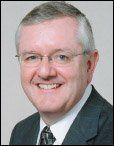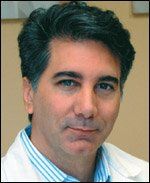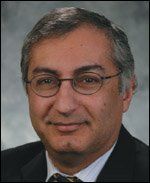Smartphones hustle to maintain pace with rapid rate of change in oncology
A flood of cancer-specific applications is answering the call of oncologists, for whom keeping pace with new clinical developments is a higher priority than for your average family practitioner.
ABSTRACT: A flood of cancer-specific applications is answering the call of oncologists, for whom keeping pace with new clinical developments is a higher priority than for your average family practitioner.

JOSEPH S. BAILES, MD
Editor
Droids, iPhones, iPads, and BlackBerrys are shock troops on the front line of an electronics invasion. Their assimilation of everyday functions has made a frustrating universe simpler and more efficient, arguing for their broader and more sophisticated use in professional life. In medicine, they entered first in general practice then quickly spread to specialties. Oncology is fast becoming a place where you're likely to hear the expression, "There's an app for that."
"Oncology is one of the few fields in medicine where things are changing at a very rapid pace, with protocols and drug regimens and research actually changing day to day the way you treat your patients," said Tom Giannulli, MD, chief medical information officer for Epocrates. "In that group of physicians, keeping in touch is a much higher priority than for your average family practitioner with respect to researching new developments."

TOM GIANNULLI, MD
The NCCN recently launched a smartphone app to view its guidelines. The app, which is specific for the iPhone and Droid, is among the first free mobile applications available that are designed to assist in the selection of treatment for patients with cancer, according to the NCCN.
What's available now
More than 900,000 medical professionals regularly use Epocrates software on mobile devices including the iPhone, Palm and BlackBerry, and PC, according to the company. They have used this software to look up drug interactions, dosing, and formulary information more than 1.2 billion times, according to the firm, which launched 10 years ago.
A competing service launched in July 2009, Medscape Mobile, provides information along the same lines: disease symptoms and treatments and data about specific drugs, including drug interactions, medical news, and continuing medical education. With 370,000 users, it ranks at the top in Apple's apps store for medical applications; its recently launched Medscape for BlackBerry app also is highly ranked in the medical category in RIM's AppWorld.
"We look for what physicians want in terms of functionality at the point of care and on the go," said David Yett, director of product management at Medscape. "We spend a lot of time listening to physicians."
The two competing services share the same goal, which is to improve the quality of patient care. Mobile devices offer enormous potential to do so. A spare few minutes in a cab or between meetings are enough to check out the risk of an adverse drug interaction or drug coverage. Pill identifiers and pictures of pills are available in an instant, along with high-resolution disease images, ICD-9 and CPT codes, and a medical dictionary. DocAlerts from the FDA are pushed to mobile devices, along with breaking news items.
"With mobile devices, you can tap into information at any point during your day," Dr. Giannulli said.
The result can save time and lives. More than 40% of oncologists reported avoiding at least two errors per week with Epocrates products, according to a recent survey by Epocrates. Forty-seven percent reported saving 20 minutes or more per day by reaching into their pockets rather than going to their desks to look up information.

THOMAS D'AMICO, MD
Being able to access NCCN guidelines at the point of care will be invaluable for clinicians who want to keep up with the latest treatment recommendations, and mobile devices are the way to do it, said Thomas D'Amico, MD, chair of the NCCN board of directors. "Mobile devices have quickly become a preferred vehicle for physicians to access clinical information due to their ease of use and inherent portability," added Dr. D'Amico, who is also director of clinical oncology at Duke Comprehensive Cancer Center in Durham, N.C.
According to a May 2010 report by Manhattan Research, 72% of U.S. physicians now use smartphones. This share is expected to grow to 81% by 2012.
"Professional uses of smartphones and online user-generated content are no longer early adopter activities of a tech-savvy few," said Meredith Ressi, vice president of research at Manhattan Research. "These types of activities are the norm for the majority of physicians today."
Information on the go
A drawback with some handheld devices is that, the bigger the document, the more difficult it is to read. Whether it was coincidence, fate, or design, the timing couldn't be better for the arrival of Apple's iPad, which offers a viewing surface ideal for reading, especially longer news or clinical articles. Physicians were quick to tune in.
Within the first 48 hours of the launch of iPad, WebMD for iPad was first in downloads of all the free apps in the iTunes store for this new device and first among applications related to healthcare, according to WebMD. WebMD estimates that about 10% of all iPad users have downloaded its app for iPad.
A larger viewing surface is needed when looking at large documents; palm-sized devices just don't cut it, says Richard B. Reiling, MD, medical director of the Presbyterian Hospital Cancer Center in Charlotte, N.C.

RICHARD B. REILING, MD
"You can only get about a quarter of a page, so you're missing the other side, and then, if it's a technical article that refers to a chart, you have to try to find the chart," Dr. Reiling said. "It makes me wonder if the iPad might be a better way to go."
But the iPad is on the fringe of the mobile revolution. Just as its thin lines and sleek styling are striking at first sight, so is the weight of the device surprising at first touch. It doesn't fit in a pocket "and you can't hang it around your neck," he said.
Applications engineers are being challenged to respond. They do so by keeping their presentations simple and tailored to the displays onboard mobile devices. But not all challenges come from response to their small size.
Mobile devices are not always in contact with the Internet; for example, when flying at 30,000 feet. Here is where information downloads by smartphones come in. A drug interaction database may be downloaded to the flash RAM that serves as a kind of hard drive on mobile devices. These apps typically are available alongside those for tapping into the online databases.
"They're there for when you don't have wireless connectivity. Most clinicians encounter poor or nonexistent connectivity at the hospital or practice settings. Our app allows the complete drug reference and interaction checker to work offline along with a treatment and disease reference covering nearly 4,000 topics," Mr. Yett said.
And, just as the most specific capabilities of a cellular phone are being leveraged, so are the most sophisticated of them being challenged to handle what was once found only on desktop PCs and workstations. Such broader functions are coming into play with zero-footprint technologies that allow mobile devices to tap in to patient medical records like web browsers connect with websites. Dr. Reiling said he takes advantage of such a system installed at Charlotte's Presbyterian Hospital.
"It's always disturbing to have a patient change rooms in the middle of the night, and you arrive at the hospital the next morning and can't find your patient," Dr. Reiling said.
"My BlackBerry keeps me up on those changes and gets me the lab work, so I'm not running down to nursing services to get a patient's hemoglobin."
Point of care access via smartphones can provide updates on changes in patient vitals, lab results, and chemotherapy administration. Remote access provides an in-depth look at the clinical history and current treatment of patients, which comes in handy when one oncologist is covering for another, especially when patient and physician are both offsite.
As the U.S. gears up to embrace electronic medical records on the heels of the Obama stimulus plan, the professional use of these consumer-oriented and, therefore, inexpensive and widely available devices is sure to grow.

"Frequently, Twitter is where I first get a heads-up on what's going on [in oncology]." - WAFIK S. EL-DEIRY, MD, PhD Tweeting to keep up with clinical care
Twitter has gained about 18 million users worldwide since it was launched four years ago, and physicians are turning out to be enthusiastic tweeters. Wafik S. El-Deiry, MD, PhD, chief of hematology/oncology at Penn State Hershey Cancer Institute in Hershey, said he uses Twitter to tell colleagues about advances in genetics and therapies related to cancer.
"If you follow a group of tweeters from whom you derive information about a topic of interest, you are likely to hit upon everything important," he said. "Frequently, Twitter is where I first get a heads-up on what's going on."
Dr. El-Deiry said that he tweeted key findings from colorectal cancer presentations at ASCO 2010. These tweets also serve as his personal notes for postconference review. "It's really good to have a record of what was going through my head when sitting in those sessions, hearing things for the first time," he said. The 140-character limitation forces him to be succinct, he explained, and because there is no limit on the number of follow-up tweets, he can send as many tweets as he needs.
Newsletter
Stay up to date on recent advances in the multidisciplinary approach to cancer.
Oncology Peer Review On-The-Go: Cancer Care Management During the COVID-19 Pandemic
October 28th 2020The newest episode of Oncology Peer Review On-The-Go speaks with 2 authors of an article from the October Issue of the journal ONCOLOGY focusing on effective cancer care management during the coronavirus pandemic.